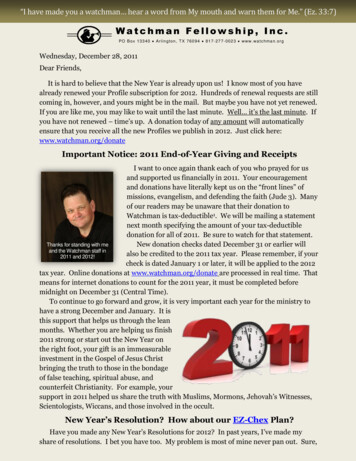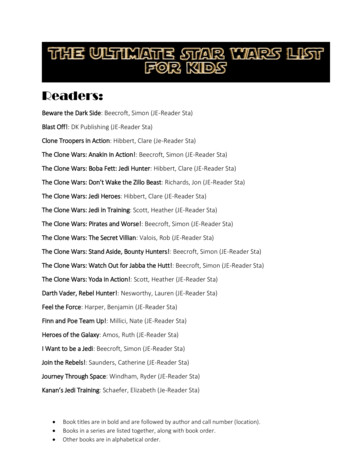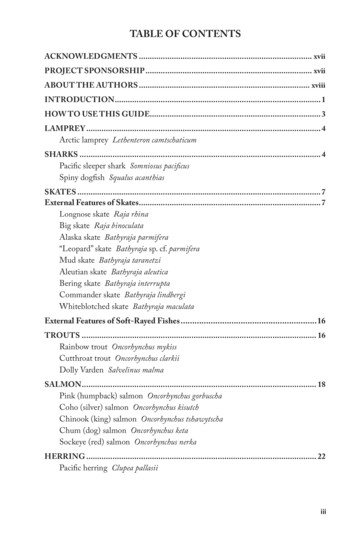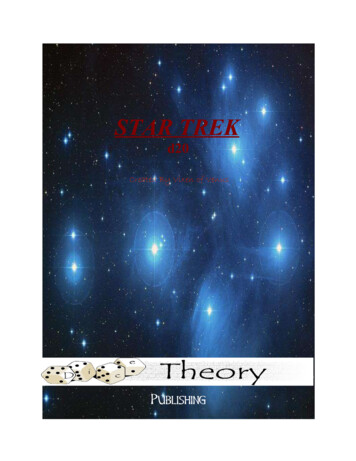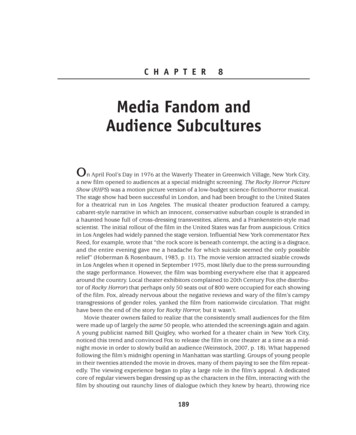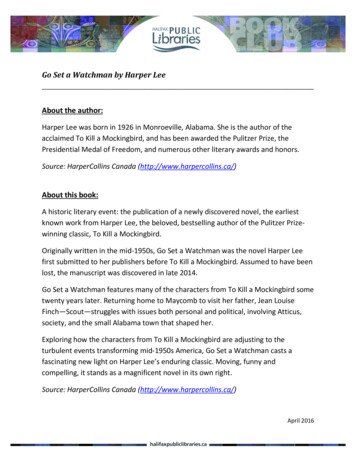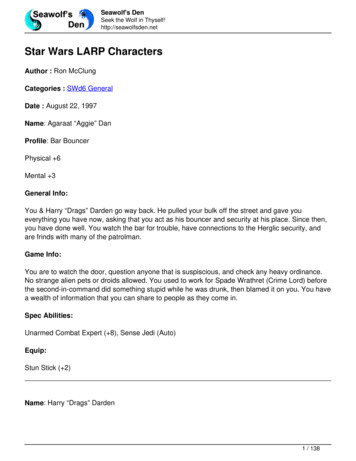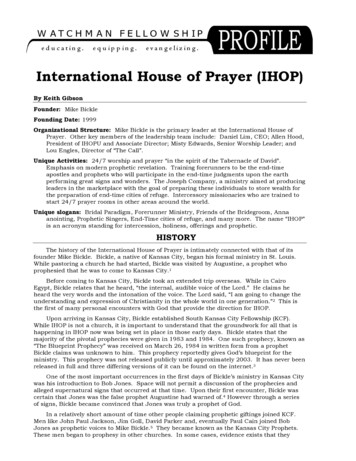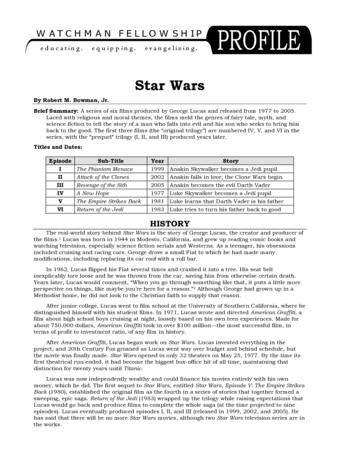
Transcription
Star WarsBy Robert M. Bowman, Jr.Brief Summary: A series of six films produced by George Lucas and released from 1977 to 2005.Laced with religious and moral themes, the films meld the genres of fairy tale, myth, andscience fiction to tell the story of a man who falls into evil and his son who seeks to bring himback to the good. The first three films (the “original trilogy”) are numbered IV, V, and VI in theseries, with the “prequel” trilogy (I, II, and III) produced years later.Titles and Dates:EpisodeIIIIIIIVVVISub-TitleThe Phantom MenaceAttack of the ClonesRevenge of the SithA New HopeThe Empire Strikes BackReturn of the JediYear199920022005197719811983StoryAnakin Skywalker becomes a Jedi pupilAnakin falls in love; the Clone Wars beginAnakin becomes the evil Darth VaderLuke Skywalker becomes a Jedi pupilLuke learns that Darth Vader is his fatherLuke tries to turn his father back to goodHISTORYThe real-world story behind Star Wars is the story of George Lucas, the creator and producer ofthe films.1 Lucas was born in 1944 in Modesto, California, and grew up reading comic books andwatching television, especially science fiction serials and Westerns. As a teenager, his obsessionsincluded cruising and racing cars. George drove a small Fiat to which he had made manymodifications, including replacing its car roof with a roll bar.In 1962, Lucas flipped his Fiat several times and crashed it into a tree. His seat beltinexplicably tore loose and he was thrown from the car, saving him from otherwise certain death.Years later, Lucas would comment, “When you go through something like that, it puts a little moreperspective on things, like maybe you’re here for a reason.”2 Although George had grown up in aMethodist home, he did not look to the Christian faith to supply that reason.After junior college, Lucas went to film school at the University of Southern California, where hedistinguished himself with his student films. In 1971, Lucas wrote and directed American Graffiti, afilm about high school boys cruising at night, loosely based on his own teen experiences. Made forabout 750,000 dollars, American Graffiti took in over 100 million—the most successful film, interms of profit to investment ratio, of any film in history.After American Graffiti, Lucas began work on Star Wars. Lucas invested everything in theproject, and 20th Century Fox groaned as Lucas went way over budget and behind schedule, butthe movie was finally made. Star Wars opened in only 32 theaters on May 25, 1977. By the time itsfirst theatrical run ended, it had become the biggest box-office hit of all time, maintaining thatdistinction for twenty years until Titanic.Lucas was now independently wealthy and could finance his movies entirely with his ownmoney, which he did. The first sequel to Star Wars, entitled Star Wars, Episode V: The Empire StrikesBack (1980), established the original film as the fourth in a series of stories that together formed asweeping, epic saga. Return of the Jedi (1983) wrapped up the trilogy while raising expectations thatLucas would go back and produce films to complete the whole saga (at the time projected to nineepisodes). Lucas eventually produced episodes I, II, and III (released in 1999, 2002, and 2005). Hehas said that there will be no more Star Wars movies, although two Star Wars television series are inthe works.
THE BEST RESOURCE COLLECTION ON CULTS AND RELIGIONSThe Watchman Fellowship ProfileNotebook provides you with an extensive personal library of information about cults, new and alternative religions, world religions, andreligious leaders. You will have atyour fingertips over twenty years ofresearch to answer your questions,strengthen your faith, and improveyour witness to others. Over 100 ProfilesOver 400 pages of informationThe history and primary teachings ofeach groupA Christian responseto deepen your faithand enhance your outreachClick here to order your copy of the watchman fellowship profile notebookBe sure to also order your free subscription to the Watchman Fellowship Profile. Several timeseach year you will receive a new, four-page Profile that you can add to your Profile Notebook, aswell as the latest news from Watchman Fellowship. Click here to order your free subscription!
Star Wars, page 2DOCTRINESStar Wars is not a religion and does not teach a specific set of doctrines in the conventionalsense. Yet everyone agrees that George Lucas intended to convey certain ideas or beliefs of relevanceto religion. Lucas is adamant about the films having a message. On the other hand, to those fanswho take the movies far too seriously, Lucas has also protested, “Come on, they’re only movies.”3The Genres of Star Wars:. The Star Wars films fuse together several rather different genres ofstorytelling: science fiction, fairy tale, and myth, with other genres (notably Westerns and comicbooks) adding additional elements to the total picture.4 The science fiction elements are obvious:faster-than-light space ships, a galactic Empire at war, and the common science fiction theme ofman versus machine.However, Lucas prefers to describe Star Wars as a fairy tale—a moralistic tale involving a makebelieve world of enchantment, usually set in imaginary, far-away lands and often in an unspecifiedpast: “Once upon a time, in a distant land.” Lucas makes the fairy-tale setting of Star Wars explicitwith the opening crawl, “A long time ago in a galaxy far, far away .” For Lucas, the fairy-taleelements—the exotic locations and magical happenings—are window dressing for stories designed toteach children right from wrong: “Fairy tales are how people learn about good and evil, about how toconduct themselves in society.”5Star Wars and Myth: By his own account, in Star Wars Lucas “consciously set about to recreate myths and the classic mythological motifs.”6 For Lucas, “myths” are fictional stories thatteach life lessons. The most important figure shaping Lucas’s views on myth and religion wasJoseph Campbell (1904-87). Campbell argued that a monomyth can be discerned in all religions—amyth of the hero’s adventurous journey to obtain a prize. On the basis of this view of the world’sreligions, Lucas felt as comfortable mixing and matching elements of different religions andmythologies in the Star Wars movies as he did ransacking fairy tales, literature, and movies forthematic elements.God, Religion, and “the Force:” The central religious element in Star Wars is “the Force.”Lucas explains, “I put the Force into the movie in order to awaken a certain kind of spirituality inyoung people—more a belief in God than a belief in any particular religious system. I wanted tomake it so that young people would begin to ask questions about the mystery.”7 Lucas stresses thathe is not advocating the religion of the Force as the answer to these questions. “That’s why I wouldhesitate to call the Force God. It’s designed primarily to make young people think about themystery. Not to say, ‘Here’s the answer.’”8The Symbolof the TaoAlthough Lucas denies that the Force represents any particular religion’s takeon God, it is clear that the Force is explained in the movies along lines quitesimilar to Taoism (pronounced DOW-ism), a Chinese religion with some affinities toBuddhism. In Taoism, “the Tao” has a light and a dark side, but neither side ispure: there is always a little light in the darkness and a little darkness in the light(as represented by the famous circular symbol of the Tao). This belief that ultimatereality has two sides is called dualism.“The Force”“The Tao”The Force “flows” through the JediThe Force is an energy created by lifeThe Tao often compared to flowing waterThe Tao is an energy that produced all lifeThe Force empowers a Jedi but also obeyshis commandsCalmness, nonaggression as the “good side;”anger, aggression, hatred as the “dark side”The Tao empowers all life but “does notdemand to be Lord”Calmness, nonaggression as yang (the“light” side); anger, aggression as yinGood to be found even in the evil Vader;some anger even in the good LukeGood found within all so-called evil, andsome evil within all so-called good“Letting go” to allow the Tao (or ch’i) to flow“Letting go” in order to feel the Force movethrough youPossibility of longevity (Yoda lives to be 900years old)The Empire seeks control, order; theRebellion seeks freedom, bringing “balanceto the Force”Possibility of longevity (some Taoistsreported to live for centuries)Confucianism emphasized order, structure;Taoism emphasized balance, simplicity
Star Wars, page 3Lucas has admitted a connection to Eastern religions but insists that the Force represents abroader, more universal approach: “I didn’t want to invent a religion. I wanted to try to explain in adifferent way the religions that have already existed. I wanted to express it all.”9 His desire to createa religion for his characters that connected with all of the different religions of the real world wasbased on his own personal belief, as he plainly says, “that all the religions are true.” According toLucas, this is the conclusion he has reached in answer to the question of why there are so manyreligions if there is only one God.10As we have seen, the concept of the Force in Star Wars has much in common with dualism.Another concept of God in Eastern religions is pantheism, the doctrine that God is all, or that God isthe divine reality underlying everything that we see and experience. There is a very thin line betweena dualism that views God as the ultimate reality manifest in both good and evil and a pantheismthat views God as the ultimate reality in everything.Although Star Wars is dominated by Eastern religious motifs, some of its religious elementsderive from Christianity. The oft-repeated statement, “May the Force be with you,” is an adaptationof the Christian liturgical prayer, “May the Lord be with you.” In Phantom Menace, Qui-Gon speaksof “the will of the Force,” an expression that parallels the phrase “the will of God.” Such languageimplies some sort of personal nature for the Force, in tension with the impersonal implications ofthe very term “Force.” For himself, Lucas says that he is sure that there is a God but unsure as towhat God is.11Obi-Wan and Christ: In the original Star Wars, Obi-Wan Kenobi allows himself to be killed byDarth Vader so that the others can escape the Death Star, a sacrifice that seems to allude to Jesus’death on the cross. “If you strike me down,” Obi-Wan warns Darth Vader, “I shall become morepowerful than you can possibly imagine.” During the rest of the story, Obi-Wan is able to speak toLuke, encouraging and guiding him, in a way that reminded many Christians of the inner guidanceof the Holy Spirit. In other respects however, Obi-Wan’s death is quite unlike Jesus’ death. Obi-Wandoes not rise from the dead; in subsequent episodes (Empire and Jedi) he returns as a luminousspirit, more in the tradition of Greek mythology than biblical theology. He functions more like thespirit-guides of Native American and New Age belief than the Holy Spirit.Anakin and Christ: The most controversial allusion to Christianity in the Star Wars sagacomes in Phantom Menace. Qui-Gon has Anakin’s blood tested and discovers that he has a higherconcentration of ‘midi-chlorians’—microscopic conveyors of the Force—than anyone else. Curious,Qui-Gon asks Anakin’s mother Shmi who the boy’s father was. “There is no father,” she answers.Later, Qui-Gon tells the Jedi Council that Anakin may have been “conceived by midi-chlorians.”This comes very close to identifying Anakin as the son of the Force. The allusion to the VirginBirth of Christ is obvious. No doubt Lucas introduced this element into the story under theinfluence of Joseph Campbell, who argued that the story of a virgin who miraculously bore a childwas part of the monomyth of the hero.12 The “virgin birth” of Anakin is part of a larger picture of thisparticular hero: Qui-Gon thinks that Anakin is “the Chosen One” who was “prophesied” ages agoand who “will bring balance to the Force.” Clearly, the religious figure on whom these descriptionsare based is the biblical Christ.Redemption: On the other hand, Anakin is a flawed hero, one who will fall prey to the darkside of the Force and become an agent of evil. Anakin will eventually “bring balance to the Force”when his son wins him back to the good side and Anakin destroys the evil Emperor. As Lucas hassaid, the series of films as a complete series are “about how young Anakin Skywalker became eviland then was redeemed by his son.”13 As Lucas uses the term, children “redeem” their parents bybringing the best out of them and forcing parents to become responsible, loving people—somethingLucas sees his own children as having done for him.CHRISTIAN/BIBLICAL RESPONSEStar Wars blends elements of science fiction, fairy tale, myth, and religion to produce aromantic adventure story with a moral and spiritual challenge. How should Christians view the StarWars movies?Star Wars as a religion: Although Star Wars was created to function as a modern myth, Lucashimself has criticized the extremes to which some fans have gone in making Star Wars their actualreligion. There are whole Web sites devoted to proclaiming the message of the Force, taking the
Star Wars, page 4fictional religion of the Jedi in an extremely literalistic way.14 Not only have these peoplemisunderstood the meaning of the films, their belief is false. There is no literal “Force”; there is,however, a real God, who has revealed himself in the Bible.God: The personal God of the Bible (Ex. 3:14; Heb. 1:1-2) is quite different from the impersonalForce of Star Wars. An impersonal Force can be used; a personal God must be trusted. Rather thanteaching our children to trust their own feelings, as Star Wars does, the Bible would have us teachour children to trust in God (Prov. 3:5-6). The God of the Bible is the Creator of all things (Gen. 1:1;Rom. 11:36). As such, he is our absolute Lord and Judge (Gen. 18:25; Matt. 11:25; James 4:12).Whereas most of the characters in Star Wars can live without a knowledge of the Force and be fine,the Bible makes clear that every human being is accountable to God (Rom. 3:19-20).Redemption: People are redeemed by God’s grace, not by their own effort. An impersonal Forcecannot change the heart; a personal God can. The heroes of Star Wars must somehow changethemselves, overcoming their own fear, anger, and greed by their own resources. That is indeedwhat most religions teach. But Christianity is different: the Bible summons us to admit humbly thatwe cannot redeem ourselves and to turn to God in Christ to redeem us (Rom. 3:19-26; Eph. 2:8-10).Myth: Lucas’s major error as reflected in Star Wars is his belief that Christianity shares with allother religions the same fundamental myth. Christianity is based on fact and actually rejects myth(2 Tim. 4:3-4; 2 Pet. 1:16). A myth is a non-historical story with religious significance, like theHindu stories about Krishna. The primary stories of religious significance in the Bible are notmyths, but sacred history. Unlike myths, which teach moral lessons that don’t assume the truth ofthe stories, the sacred history of the Bible is a revelation of what God has actually done for us.If Jesus did not really rise from the dead, then the New Testament’s claim that in Jesus wehave the hope of resurrection and eternal life in a reconciled relationship with God is utterly withoutfoundation (1 Cor. 15:12-19). Myths make no pretense to have taken place in actual space-timehistory. That is why Star Wars begins with the words, “A long time ago in a galaxy far, far away.”Contrast those words with texts in the Gospels like this: “Now in the fifteenth year of the reign ofTiberius Caesar, when Pontius Pilate was governor of Judea” (Luke 3:1). These words serve to placethe story of Jesus in a real time and place.As young people thrill to the mythic story of the hero who overcomes evil and saves the galaxy,we should enthusiastically tell them the Greatest Story Ever Told, about a Man who really didovercome evil and gave his life to save the world from sin and death. And this story, as amazing as itis, actually is true.Robert M. Bowman Jr., formerly on staff with Watchman Fellowship is now the director of the Center for BiblicalApologetics (http://www.biblicalapologetics.net).Notes1234On Lucas’s life, see Dale Pollock, Skywalking: The Life and Filmsof George Lucas, updated ed. (New York: Da Capo Press, 1999).Jean Vallely, “The Empire Strikes Back and So Does FilmmakerGeorge Lucas with His Sequel to Star Wars,” in George Lucas:Interviews, ed. Sally Kline; Conversations with Filmmakers(Jackson: University of Mississippi, 1999), 95-96.Pollock, Skywalking, 271-72; cf. “Of Myth and Men: Aconversation between Bill Moyers and George Lucas on themeaning of the Force and the true theology of Star Wars,” Time,26 April 1999, 92.I discuss the different genres of Star Wars at much greaterlength in an earlier article, “The Gospel according to Lucas, PartI: Fantasy Movies or Phantom Menace?” Vantage Point, Fall1999; http://www.wfial.org/index.cfm?fuseaction artNewAge.article 4.Quoted in Aljean Harmetz, “Burden of Dreams: GeorgeLucas,” in George Lucas: Interviews, 143.6 “Of Myth and Men,” 90.7 Ibid., 92.8 Ibid., 93.9 Ibid., 92.10 Ibid.1 Ibid.12 Joseph Campbell, The Hero with a Thousand Faces,Bollingen Series 17, 2d ed. (Princeton: PrincetonUniversity Press, 1968), 297-314.3 “Of Myth and Men,” 94.4 E.g., the Yahoo Group called m/ (accessedMay 2005).5Profile is a regular publication of Watchman Fellowship, Inc. Readers are encouraged to begin their ownreligious research notebooks using these articles. Profiles are published by Watchman Fellowshipapproximately 6 times per year, covering subjects such as new religious movements, counterfeitChristianity, the occult, New Age Spirituality, and related doctrines and practices. Complete ProfileNotebooks containing all the Profiles published to date are available. Please contact WatchmanFellowship for current pricing and availability. All rights reserved 2005.
Star Wars By Robert M. Bowman, Jr. Brief Summary: A series of six films produced by George Lucas and released from 1977 to 2005. Laced with religious and moral themes, the films meld the genres of fairy tale, myth, and science fiction to tell the story of a m
